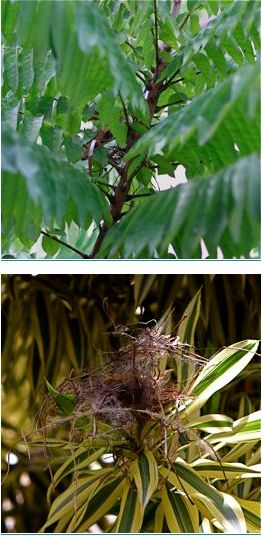For the last one month and more, I have been keeping an eye on a nesting pair of Yellow-vented Bulbul (Pycnonotus goiavier) in my small belimbing tree (Averrhoa belimbi).
The birds took about a week to build their simple nest, tucked between the bases of the compound leaves near the top of one of the many leading shoots. The nest was not obvious and was just above eye-level. It looked just like a mass of dead leaves stuck on to the leaf bases (above left).
Whenever I walked past the tree, as I often did a few times a day, I could only see traces of the dried leaves that made up the nest. Tried as I did, I could not see any sign of a bird incubating the eggs. However, once I caught signt of a tail on the nest (above right). But a bird was always there. Once when I was watering my garden, I accidentally sprayed the tree where the nest was. A bulbul immediately flew off and perched on a nearby branch eyeing me suspiciously.
And for the last few weeks the adults were taking turn incubating the eggs, arriving and departing quietly. Only during these periods did the branch showed signs of disturbance. The eggs were not ready to hatch but probably about to. Once hatched there would be some commotions, as the chicks would beg for food as soon as the adults arrive.
But it was not to be. Hatching, I mean.
This morning, 26th June, I was attracted to the nesting site by the clear view of the nest (left top). Not actually the nest but the nesting materials that scattered about among the leaf bases. Usually only traces of brown nesting materials were seen.
On close scrutiny, I was disappointed to find a number of the belimbing leaves detached and scattered on the ground below. The nest was in shambles but there were no traces of nesting materials on the ground, only the detached green leaves.
The nest must have been raided. The intensity of the attack left many leaves broken off from the stem and most of the nest gone. No traces of eggs even. All these must have been taken away during the attack.
A few days later I found part of the destroyed nest on another tree about 10 meters away (left bottom).
Who was responsible. Black-naped Oriole (Oriolus chinensis)? A squirrel or a monkey? But I have never seen monkeys in my garden, although they are around the area.
YC Wee
Singapore
September 2008










